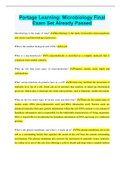Exam (elaborations)
Portage Learning: Microbiology Final Exam Set Already Passed
- Course
- Institution
Portage Learning: Microbiology Final Exam Set Already Passed Microbiology is the study of what? Microbiology is the study of microbes (microorganisms and viruses) and their biological processes. What is the smallest biological unit of life? A cell What is a macromolecule? A macromolecule is class...
[Show more]



